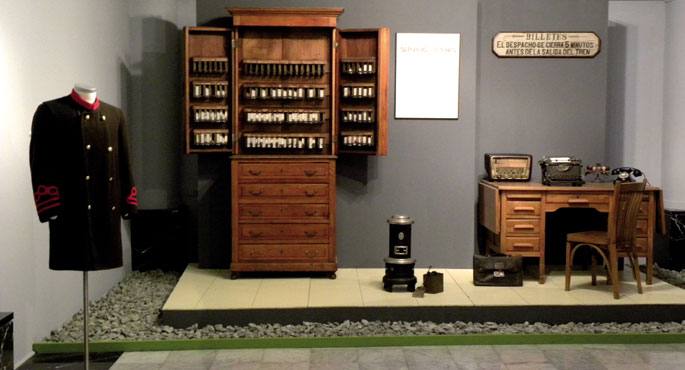When the Basque industry took the train

Trains 150 years in Euskadi
Travelling exhibition
Where: Centro Cultural Amaia, Irún. Date: until 28 April. Organises: Museo Vasco del Tren.
“I’ve always been clear that the time we’re waiting for in train stations is a gift to the senses.” These are words written by the director of the foundation of the Basque Museum of Railways, Maitane Ostolaza, in the foreword of the exhibition catalogue. And whoever approaches the Amaia Cultural Center of Irun before April 28 can immerse himself through listening in the 150 years of history that the train has had. Through the headphones, from the coffeemaker of the steam machines to the sound of the modern electric trains, you can hear a number of audios: the whistle of the old trains, the atmosphere of the station…
Several photographs and explanatory texts have been placed on the walls. But the most interesting elements of the exhibition are the objects: workers’ berets, tachographs, travel tickets (among other things, it was worth 0.15 pesetas the ticket of the old train of the Urola), mythic drill of wallets, original drawings of locomotives, trumpets of station chief… If we had to choose the podium of the most beautiful pieces, they would get the medal North Company (1950) and Fire. An old station office has been rebuilt and care has been taken of the decor that helps to ambition: in some places the traditional gravel of the railways has been thrown and vitrins have been placed on oxidized rails.
Rail and industrialisation.
The oldest object of the exhibition is the wall clock of the Triano station of 1865. The railways were essential for the transport of raw material from the mines of Triano to the ferries and, in general, for the development of new industrial spaces. Revolutionary transport was therefore of great importance in Bizkaia and, in particular, in the Bilbao area. A few weeks ago Mikel Iturralde complained in the blog Treneando: “Indifference, disinterest, apathy and laziness. The 150th anniversary of the arrival of the train to Bilbao has gone unnoticed. Not a single institutional act in memory of the ephemeris, even though the city (and the territory) owes so much to the railroad.”
For Irun the train was also important (and for the Irun train). As a strategic situation, the route of the Northern Railway, the Bidasoa, the Topo, the lines from France and the tram to Hondarribia, at the time, departed and ended there. It is a travelling exhibition that at the Irun stop have prepared a special section dedicated to the border city. Therefore, in some places, the arrival of the train has received a well-deserved tribute.
Late or too early.
The exhibition shows the charm of this means of transport, but it also has weak points. Just as the traveler waiting at the station runs the risk of losing patience when the train arrives late, the visitor of the exhibition in Euskera will also need patience if he wants to read the Basque mistranslation of the texts of the panels.
Nor will the traveller who has lost his train be happy because he has arrived earlier. The exhibition conveys the idea that the train was fundamental in the configuration of the industrial character of the Basque Country. Therefore, the large section dedicated to the high-speed train at the end of the exhibition slightly aggravates the embarrassment left by the old objects; a unilateral apology of the TAV is made, forgetting that part of the Basque society considers it irrelevant and harmful for the future.
Beasaindik Otzaurteraino doan trenbidearen eraikuntza eta historia aztertu dute Pello Joxe Aranburu eta Luis Mari Intzak. Liburua ikerlan zabalago baten bigarren zatia da eta hilaren 17an aurkeztuko dute Zegaman. Otzaurteko pasabideak buruhauste ugari eman zien XIX. mendeko... [+]












